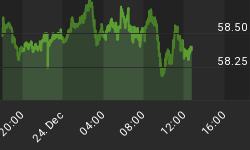Despite the year's heavy handed dollar induced commodity deflation, gold prices have been acting generally well. Copper prices, however, broke down from a broadening pattern of prices late last week, on a rise in open interest, indicating aggressive short sellers were at work. Yet gold prices were able to rally with equal intensity, indicating to us the possibility that dollar bulls (commodity bears) cashed in their gold shorts in favor of the weaker industrial metal.
Having said that, we need to remain vigilant about if and when Phelps Dodge will cut production? Perhaps as soon as their energy costs rise again… which frankly, might be as early as this week. Furthermore, the US housing market is strong. Sales of new and existing homes in April totaled an annual rate of 6.1 million - just shy of the record pace of 6.2 million units set in the first quarter.
Additionally, some of the Agricultural commodities have been acting better over the past month or so, and today the USDA (US Department of Agriculture) reported several slight reductions in ending stocks estimates for 2001-2002. Cereal prices are trending, strongly, wheat prices have been more than just firm, and even the soybean markets look perky over the past few weeks. The Goldman Sachs Agricultural index reflects these bullish pressures. Weather conditions are expected to worsen in key parts of the United States this summer, and an increasing regulatory burden on farming in the US, particularly in California, has undoubtedly contributed as much as Fed policy has to the relative stickiness of prices regardless that dollar bulls literally step all over the other global currencies.
Gold prices will likely get some direction if our stock market outlook proves correct, but they will need a declining dollar to sustain.
It's Still a Bear Market
We have observed a series of short term topping patterns in the popular averages: the S&P 500 may be developing a 6 week head & shoulders, with support at 1233 in the cash market. The NASDAQ and AMEX reveal similar patterns, but could be interpreted as triple tops. The NYSE composite index, on the other hand, has today traded through support at roughly 635. The Dow transports have also broken down today. If the Dow Industrials fall below nearby support at 10700, we expect a sharp sell off. All of these markets are in a primary to intermediate bear market, so the surprise remains on the downside. Our call is for Dow 7000!
As the week unfolds, markets will reconcile their inflation expectations to that of the government's figures: import prices on Wednesday, the PPI on Thursday, and the CPI on Friday. Expectations are for the reported rates to come in slightly higher than last month. The surprise everywhere else (except for Japan) has been on the upside, so the risk is to the dollar, and financial assets, this week. We further expect that gold prices will soon factor in a new paradigm - referred to by Rob Weinberg, new head of institutional investment at the World Gold Council, in his speech at the council's 15th annual meeting in May - and that the fund buying, which has been oft cited of late, will continue to persist over the medium term.
U.S. Dollar Losing Breadth
The Canadian Dollar has run off to make a higher high, and is leading the Aussie dollar now too, even as the trade weighted dollar index runs off to yet another high. Dollar bulls are feeding off of the weak sentiment in the pound and euro at the moment. The euro is only approaching its October 2000 low against the dollar, but the pound is already off to new lows as the Conservatives have been fear mongering British Voters into forsaking the euro, in favor of the dollar.
In our opinion, the ECB cannot afford to see the euro break down, with inflation rates as high as they are right at the moment. We expect that they will act this month if the pressure on euro persists. Forex activity today may already be discounting that, as the euro was last seen up nearly ½ of a US penny - though the rumors cited potential ECB intervention in the Forex market. Nonetheless, we fully expect that a rise in interest rates by the ECB will be good for the Euro as it just may invert the TED spread.
Dollar/Yen looks shaky. Weak economic reports out of Japan have put slight pressure on the Yen, but outperforming asset markets, particularly the JGB's, in Japan have mitigated that for now. Unless the Dollar can make a higher high against yen, the primary trend for dollar/yen is still down… believe it or not.
So while the dollar index storms onwards and upwards, we see that its breadth is contracting.
Dollar Baloney
Rising oil and gas inventories have enabled dollar bulls to pressure oil prices by playing off the rise as potential supply. We believe they have got it backwards. We see it as typical inflation induced hoarding behavior. We are confirmed in our observation by the rise in long term yields, across the board, and the decline in the yield on the inflation indexed securities offered by the US government.
Consequently, we are expecting the now oversold energy complex to come to life this summer as the effect of Fed policy grabs hold, and as the rise in inflation expectations resumes. This morning, the IEA (International Energy Agency) noted that a tight balance exists in oil markets, and called for higher prices. Brent Crude prices remain in a bullish divergence, indicating to us that declining US commodity prices are really only due to one thing: and aggressive dollar policy.
Gold bulls know what that means! Every action has an equal and opposite reaction.
















